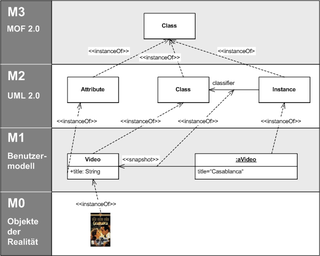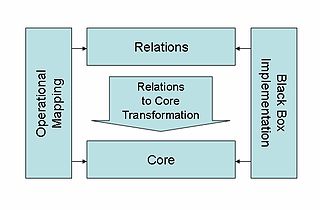Value Delivery Modeling Language (VDML) is a standard modeling language for analysis and design of the operation of an enterprise with particular focus on the creation and exchange of value. [1] [2]
In 2009, the Object Management Group (OMG) launched a Request for Proposal (RfP) to develop a standard for value modeling. The goal of this RfP is to integrate the different existing value models and give a complete overview of the business logic of an organisation. To reach this goal, the standard has to satisfy nine requirements:

The Object Management Group (OMG) is a computer industry standards consortium. OMG Task Forces develop enterprise integration standards for a range of technologies.
- The metamodel must satisfy the characteristics of the Meta-Object Facility (MOF) metamodel. MOF is a standard developed for model-driven engineering and is structured in 4 layers. The top layer (M3 model) consists of a language that is used to construct metamodels. These metamodels are the second layer (M2 model) and they describe the third layer (M1 laer). The last layer, the data layer is used to describe real objects.
- The metamodel must support the analysis of the activities of the value chain to support the identification of differentiators. The internal value chain should as such be part of the metamodel.
- A capability analysis must be possible. This is closely linked to the second requirement. A capability is the possibility to execute some sort of activity. The quality of an activity is as such dependent on the capabilities of the organisation. As such the metamodel should include a way to analyse these capabilities.
- The value model should have an adequate level of detail to include both activities and capabilities on the operational level. However a value model focuses on the inputs and outputs unlike a process model such as BPMN.
- The value model should be able to aggregate activities at multiple levels to analyse them from different angles (e.g. strategic vs operational).
- It should be possible to couple performance- and cost aspects to the activities
- The relationships with other organisations such as competitors and strategic alliances should be included.
- The events that trigger an activity should be included in the metamodel
- The user should be able to include its own specifications.
The VDML standard integrates 7 existing value models:
- Porter's Value Chain
- Business Model Ontology of Osterwalder
- Verna Allee's Value Network Analysis
- E3-Value analysis
- Resources, Events, Agents (REA) analysis
- Value Stream Mapping
- Service-Oriented Business Architecture analysis
A value chain is a set of activities that a firm operating in a specific industry performs in order to deliver a valuable product for the market. The concept comes through business management and was first described by Michael Porter in his 1985 best-seller, Competitive Advantage: Creating and Sustaining Superior Performance.
The idea of the value chain is based on the process view of organizations, the idea of seeing a manufacturing organization as a system, made up of subsystems each with inputs, transformation processes and outputs. Inputs, transformation processes, and outputs involve the acquisition and consumption of resources – money, labour, materials, equipment, buildings, land, administration and management. How value chain activities are carried out determines costs and affects profits.

Business Model Canvas is a strategic management and lean startup template for developing new or documenting existing business models. It is a visual chart with elements describing a firm's or product's value proposition, infrastructure, customers, and finances. It assists firms in aligning their activities by illustrating potential trade-offs.
Value network analysis (VNA) is a methodology for understanding, using, visualizing, optimizing internal and external value networks and complex economic ecosystems. The methods include visualizing sets of relationships from a dynamic whole systems perspective. Robust network analysis approaches are used for understanding value conversion of financial and non-financial assets, such as intellectual capital, into other forms of value.
The use of VDML diagrams to support business model innovation is discussed in [3]
VDML has been applied to a use case in manufacturing. [4] It demonstrates the use of VDML for modeling and analysis of a proposed change to an as-is business system.








